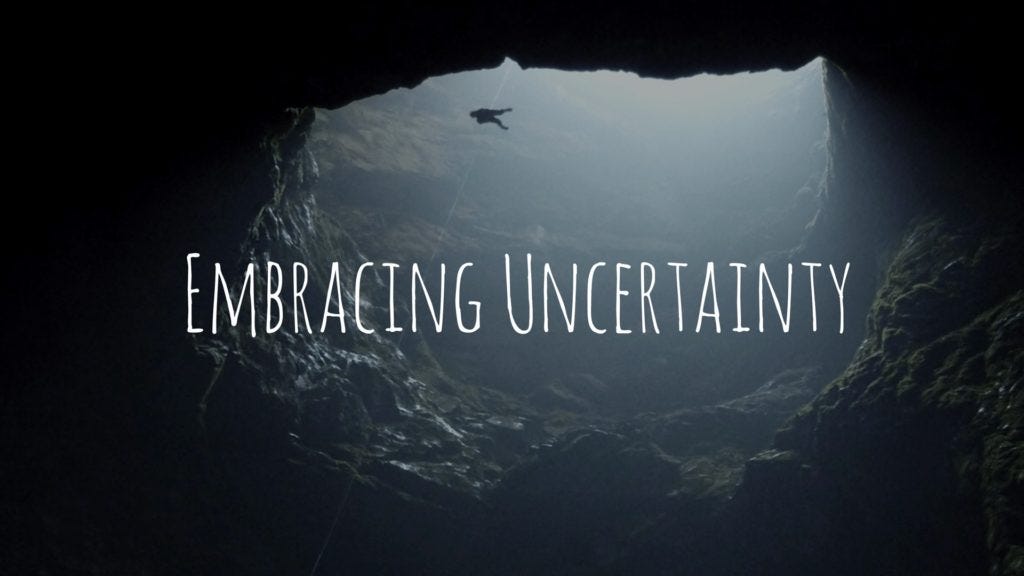Chaos Theory
For want of a nail...
“Does the flap of a butterfly’s wings in Brazil set off a tornado in Texas?”
This was the title of a 1972 dissertation on Chaos Theory by MIT mathematician and meteorologist Edward Lorenz at the 139th meeting of the American Association for the Advancement of Science.
The question was never meant to be answered by the way…
The origins of chaos theory?
In 1961 Edward Lorenz made a discovery that would presage what is often called the 3rd scientific revolution of the 20th century – chaos theory (after relativity and quantum physics).
He worked with a system of equations to predict the weather because he wanted to recreate a past climate sequence using a computer model based on a number of variables including wind speed and temperature. One day, Lorenz rounded the value of these variables to only three decimal places instead of the six he had been using, and he observed that this tiny change drastically transformed the whole pattern of two months of simulated weather. This way, Lorenz demonstrated that seemingly insignificant factors can have a huge effect on the final outcome.
Chaos theory states that small (even tiny) changes in initial conditions have the potential to escalate to much bigger differences in the future.
If something is highly sensitive to subtle changes in its trajectory, the future state is very difficult to predict.
The proverb below captures the essence of the sensitive dependence of the initial conditions in a system:
For want of a nail the shoe was lost.
For want of a shoe the horse was lost.
For want of a horse the rider was lost.
For want of a rider the message was lost.
For want of a message the battle was lost.
For want of a battle the kingdom was lost.
And all for the want of a horseshoe nail.
We tend to assume that problems have single and proximal causes, but as interdependency increases we must learn to think in new ways.
- “The kingdom was lost because the battle was lost!” (we immediately infer)
- “But what about the nails?” (someone may ask)
- “What nails?” (we won’t even consider that remote possible connection)
The best answer to this flaw is to cultivate ‘systems thinking’, a set of synergistic analytical skills that helps make sense of complexity by looking at the whole and analyzing the interdependencies and relationships within the system.
I recently came across the following reading a history book:
“wars are decided in the decades before they begin, not by the sudden appearance of an event.”
The Butterfly Effect
This concept has been made popular in several movies, even as the title of one (Havana, Run Lola Run, Frequency, The Butterfly Effect) where normally the term is used to emphasize the outsize significance of small occurrences over time. “a butterfly can flutter its wings over a flower in China and cause a hurricane in the Caribbean.”
However, Edward Lorenz never intended for it to be applied that way, in fact he meant to convey the opposite when he formulated his provocative question: “Does the flap of a butterfly’s wings in Brazil set off a tornado in Texas?”
His goals was to illustrate the idea that some complex dynamical systems exhibit unpredictable behaviors such that small variances in the initial conditions could have profound and divergent effects on the system’s outcomes. And it’s because of the sensitivity of these systems that outcomes are unpredictable.
The importance of this insight is that it questioned early laws introduced by Newton and Laplace, who suggested (Newton) that nature is a probabilistic mechanical system, “clockwork universe”, and (Laplace) that unpredictability has no place in the universe, suggesting if we knew all the physical laws of nature, then “nothing would be uncertain and the future”
Lorenz discovered that deterministic interpretations of the universe could not account for the imprecision in human measurement of physical phenomena. In fact his methods to describe the most likely outcomes of complex systems such as weather patterns, is still used today to generate the daily weather forecast.
The Science of Complexity
There is a great MIT Review article from 1999 by Richard Pascale on Complexity, Chaos and Management implications. (MIT Sloan Management original article, 1999) where the author states that nothing novel can emerge from systems with high degrees of order and stability, for example highly regulated industries or very rigid hierarchical organizations. On the other hand, complete chaotic systems, such as a stampede or a riot to be very graphic, lack of any form to be able to coalesce.
Generative complexity takes place in the boundary between rigidity and randomness. Think of the implications for teams and organizations.
Below an excerpt (with some edits) from this publication where the author shares the four bedrock principle of the science of complexity that are relevant to do strategic work:
Complex adaptive systems are at risk when in equilibrium. Equilibrium is a precursor to death. Avoid states of equilibrium if you want dynamic adaptation.
Complex adaptive systems exhibit the capacity of self-organization and emergent complexity. Self-organization arises from intelligence in the remote clusters (or “nodes”) within a network. Emergent complexity is generated by the propensity of simple structures to generate novel patterns, infinite variety, and often, a sum that is greater than the parts. (the escalating complexity of life on earth is an example.)
Complex adaptive systems tend to move toward the edge of chaos when provoked by a complex task. Bounded instability is more conducive to evolution than either stable equilibrium or explosive instability. (For example, controlled fire is a critical factor in regenerating healthy forests and prairies.) One important corollary to this principle is that a complex adaptive system, once having reached a temporary “peak” in its fitness landscape (e.g., a company during a golden era), must then “go down to go up” (i.e., moving from one peak to a still higher peak requires it to traverse the valleys of the fitness landscape).
One cannot direct a living system, only disturb it. Complex adaptive systems are characterized by weak cause-and-effect linkages. Phase transitions occur in the realm where one relatively small and isolated variation can produce huge effects. Alternatively, large changes may have little effect.
“Is the science of complexity just interesting science, or does it represent something of great importance when thinking about strategic work?
Treating organizations as complex adaptive systems provides useful insight into the nature of strategic work.”
Ask yourself this interesting question but don’t look for an answer, just let the mind navigate your thoughts
If we could rerun life from the beginning, would it all turn out the same?
So What?
Understand complexity to Embrace uncertainty
By getting some understanding of chaos theory and the science of complexity, we can gain a fresh perspective on leadership in a world where uncertainty reigns.
Just as the flaps of a butterfly can affect bigger things at distant spaces, anyone in a role of leadership has to navigate a complex and interconnected landscape where small unplanned actions can have significant and unpredictable consequences, perhaps greater than bigger planned actions.
This is why this week I want to leave you with something actionable.
We live in transformational and increasingly uncertain times, thus being able to help teams think clear through the business challenges of today and the untapped potential of tomorrow’s opportunities is something that cannot be underestimated.
Here a proposed framework to organize a working session to up-skill your team, that you can title “Embracing Uncertainty”, “Uncertainty and Ambiguity through the lens of chaos” or “How to develop adaptive skills”, among other possible names depending on what’s the most important message you want to leave your team with and what specific outcomes your are trying to achieve.
The outline:
Understand the Butterfly Effect: Introduce the concept of the Butterfly Effect to explain how seemingly insignificant decisions and actions can create a ripple effect of outcomes. Use real-world examples where small actions by leaders or organizations have led to significant impacts, both positive and negative. Use both the “what” and the “how” to think of examples related to actions and to behaviors.
Embrace Complexity and Ambiguity: In a world characterized by volatility and uncertainty, it’s not enough to adapt reactively but we all must embrace chaos and ambiguity proactively. Discuss the importance of being comfortable with complexity, learning how to adapt quickly and pivoting to make agile decisions in response to changing circumstances. You need to find the right balance between centralized and decentralized structures to empower decision making at the right level of the organization.
Prioritize Strategic Systems Thinking: Explore how chaos theory require us all to adopt a systems thinking approach. By considering the interdependencies and interconnectedness of various factors, we can make more informed decisions because we better anticipate potential consequences of events.
Encourage Emergent Solutions: Chaos theory suggests that complex systems can self-organize and generate emergent solutions not originally considered. Discuss how leaders can create an environment that encourages innovation, fosters creativity, and allows for the emergence of novel and effective solutions to complex challenges.
Unleash Opportunity: Emphasize the huge role that unexpected discoveries can have to change trajectory in leadership. Just as chaos theory suggests that chance events can have significant impacts, leaders should remain open to unexpected opportunities, chance encounters, and new ideas that can lead to breakthroughs. Embrace serendipity!
Train for Adaptive Leadership Skills: discuss the four principles of complexity and connect the dots to how chaos theory calls for leaders to develop adaptive skills such as resilience, flexibility, and the ability to navigate complexity through systems thinking. Share practical strategies and tools that leaders can employ to enhance their adaptive capacity. Discuss practical applications with concrete business challenges and opportunities you face.
If you organize a session around these modules you will help upgrade your team’s mental models. Through the introduction of Chaos Theory, a better understanding of how Complexity works and the discussion of how this all applies to the work environment, your team would focus on what are the competencies and behaviors they need to develop to thrive in times of complexity and uncertainty.
I hope you find today’s initiative helpful to stimulate your thinking on how to approach this topic with your teams.
…and watch out for the missing nails along the way is you want to avoid the fall of your Kingdom!
P.S. Before I go, here you have “The Treat,” where I share some of the music that kept me company while writing … Enjoy as you bid farewell to this post
“Lead yourself, Learn to live. Lead others, Learn to Build.”
If you enjoyed reading this post consider subscribing to the newsletter, joining the community and sharing your thoughts.
credits to
-American Scientist article “Understanding the Butterfly Effect” in the Physics section, by Jamie L Vernon.
-Siemens “Chaotic Fluid Dynamics Part 2 - Butterflies” by Robin Bornoff









By the way, does anyone listen to the music I share? Does it serve the purose of being aa glimpse into my universe to share with the reader or not?
Wow...Just wow! What an intellectually dense and meaningful piece! Every week is a surprise where your mind is going to venture, but this time is an especially interesting adventure ! Thank you Sebastian, there’s lots of things to ponder on in this post...